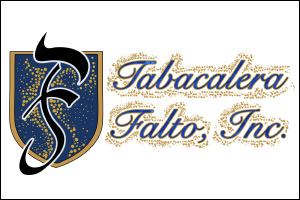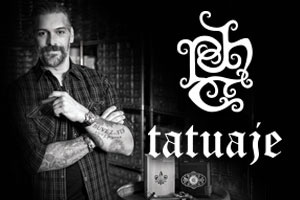Chateau de la Fuente Tour with Carlito Fuente Jr.
Scores of cigar enthusiasts worship the tobacco that comes from the Fuente farms deep in the Cibao Valley of the Dominican Republic.
Fuente Cigars have redefined Dominican tobacco, especially after the creation of Opus X, which were the first Successfully grown full-flavored, full-bodied Dominican puros.
Nailing Quality with Dominican Cigars
Dominican cigars have long had a reputation for producing high quality binder and filler tobaccos with mild character. Not many people dedicated the time and money to produce high quality, full-flavored wrappers in the Dominican Republic. Many have tried and many have failed. Most producers of Dominican cigars followed the taste trends of the day, which created the misconception that the Dominican Republic only produces mild tobaccos. Carlito Fuente followed his heart and produced a tobacco that he felt in his soul, and the result changed the way the world views Dominican tobacco. With persistence and dedication, Carlito Fuénte pulled the rug out from under the Speculators’ feet. Today, Opus X is one of the world’s most sought after cigars. Simply put, there is nothing like it. From Hemingway to Don Carlos to Opus X, each line holds its own and each tells a magnificent story that enhances any smoking experience.

Visiting the Dominican Republic and Carlito Fuente
Cigar books stack up next to baseball cards and comic books. Peter Parker collects dust as pages filled with tobacco farms wear thin. I sit back and finally smoke the first cigar I actually enjoy, a Bauza Grecos.
Over a decade later, it’s 80 degrees one late January morning and I’m sitting on the curb in front of my hotel thumbing an Opus X Chili Pepper in the Dominican Republic. I wait in front of the blinking casino lights of the Gran Almirante Hotel for Carlito Fuente to pick me up and escort me to Chateau de la Fuente, birthplace of the first cigar that I ever enjoyed.
A black Navigator pulled up with windows tinted so dark I thought the president was checking in for a holiday. My cell rang and | quickly realized that it was my ride. A man came out of the car and opened the driver’s side door. Carlito Fuente stepped out and greeted me with a warm smile and handshake.
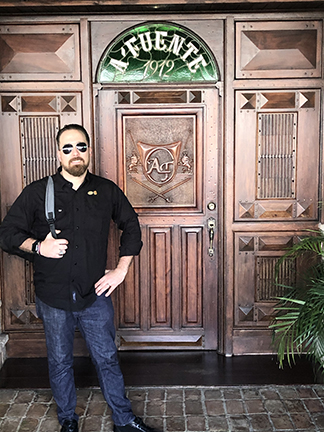 “Thor how have you been, are you ready?” he asked.
“Thor how have you been, are you ready?” he asked.
We drove away from Santiago toward the free zone of the Dominican Republic. Armed with handguns, shotguns, and M-16s, guards patrolled and secured the gates of the free trade compound. “Concrete Jungle” by Bob Marley ran through my head.
Everything was government-owned and built with concrete blocks. Nestled away in the cinder block jungle was a modest entrance that stood out from the others. A lush garden and fountain welcomed us as we entered one of the most famous Fuente factories, factory number one. A green stained-glass window with white letters reading “A. Fuente 1912” looked down on an intricate doorway created from Fuente family history. Embedded in the woodwork were Carlito’s grandfather, Arturo Fuente’s, wooden cigar molds.
Fuente Factory Number One
This was a day I had anticipated for nearly half my life. Beyond those doors was a history as rich as the soils of the Cibao Valley, and home of the cigar that launched me into a lifelong passion. I was greeted by wooden cigar store Indians and A. Fuente’s cigar rolling table as I walked through the door. Carlito guided me into his office and conference room, which was bordered with more of his grandfather’s molds and adorned with countless memorabilia from Fuente fans.
Within a few minutes we were heading into the factory, which was more like a labyrinth of history, tobaccos, rolling, and aging rooms — each room holding a significant meaning for the Fuente family.
The heavy aroma of Dominican tobacco danced across the room and smacked my senses like a siren luring me into a trance. My heart raced. I hurried to keep up with Carlito and found myself in front of a doorway under a tiled blue and white sign that read “Salon FFOX.” A security camera watched the door as two wooden Indians guarded the entrance hall. We walked inside to find about 15 cigar rollers crafting Big Bad Mother Fuckers (BBMFs), BBMF maduros, lanceros, petit lanceros, and A’s. One roller was dedicated to each of the three specialty sizes of which only 30 cigars of each are rolled a day.

To call the people at this factory cigar rollers is really an insult to their character. These are artists.
“The youngest rollers in the factory roll Opus X. They are like molding a block of clay,” Carlito explained. “We trained people who were just out of high school with no cigar making history. We didn’t want the rollers to have any previous experience because Opus X isn’t rolled like most other cigars in the market. The attention to detail and the meticulous care of each cigar is why many enthusiasts feel we make some of the finest cigars in the world. While other factories can have cigar rollers producing more than 300 cigars in a day, some of the rollers in the Opus X room roll just 30.”
I watched as one of my favorite sizes, lanceros, were being rolled. Each tobacco leaf is rolled like a straw. The roller doesn’t hold the bunch at the head of the cigar, instead he loosely holds the different straws of tobacco in his palm. Seven or eight different tobacco straws make the blend and are wrapped together by a binder to make one large straw. The cigars are then put into molds and pressed for 20-40 minutes, then turned and pressed for another 20-40 minutes, and so on.
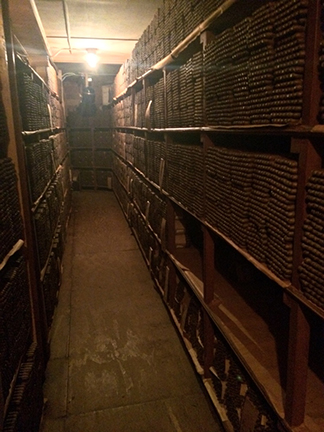
I was handed a freshly rolled corona and slipped it between my lips. My ears started to ring and I pulled a lighter to the foot and began to take slow pulls as it
rotated between my fingers. Carlito pulled me out of the Opus rolling room like a tobacco bunch stuck to an old wooden cigar mold. Right outside the Opus rolling room was a door that led directly into the Fuente Hemingway aging room. A sea of bundles waited patiently for the day to land in the hands of Fuente fans. Air purifiers and climate controls were enabled in each room. Due to the different tobaccos used for different cigars, they were kept in different rooms.
Carlito explained, “Opus X tobacco is like a sponge. Being as thick and oily as the leaves are, they need to be kept at a lower relative humidity to get the best results with the cigars. If there is excess humidity the cigars will absorb too much and they won’t age or burn properly. 63-65% is the humidity that Opus X are aged and is the best humidity in which they will burn.”
Stacks upon stacks of Hemingway Signatures, Masterpieces, Works of Art, and Short Stories – natural and maduro, were waiting in dimly lit rooms until their time comes to be read by eager palates.
We turned the corner from the Hemingway aging room to the sorting room where cigars are sorted by color. This room is dubbed “The Woman Room” because of all of the old cigar art on the walls featuring nothing but women smoking cigars. We walked into the room and over to the far side by a metal door that looked like a bullet proof vault. As you walk into the room you can feel the air cool your sweat as your shirt brushes against your back. I began to hope that the ticks of my watch slowed to half a pace. My knees became weak. I took one of the deepest breaths of my life, slowly exhaling the rich aromas of the room.
 This was the Opus X aging room.
This was the Opus X aging room.
Like a proud father, Carlito’s eyes gleamed as he looked onto some of his beautifully crafted cigars. Instinctually I felt like a kid looking at the royal crown jewels — only there were no alarms, glass cases, security guards, or ropes to keep my curious hands away.
To not dive right in was a true test of my self-control.
Light cedar cabinets encased cigars wrapped in bundles of fifty. Exotic and rare Opus X cigars were resting in a corner of the room on old and unassuming wooden shelves. Impressive cigars displaying master craftsmanship rested on shelves, all of which will probably one day end up on the chopping block raising money for the Cigar Family Charitable Foundation.
Opus X eye candy sparkled under the orange floodlight. The top shelf was filled with Brain Hemorrhages. Under them were one-of-a-kind Opus X creations. The third shelf was filled with Opus X maduros and stacks of other non-commercial Opus X sizes. For Opus X fans, this was Graceland, the Promised Land, Opus X Mecca. Opus X prototypes and cigars that Fuente fans dream about were all in hand’s reach.
Carlito should pass out Opus X bibs before letting people in this room.
The next two rooms were created to replicate Victorian architecture. Deep yellow walls and richly colored rolling tables were filled with freshly rolled Hemingways. Stacks of Short Stories and Signatures draped across tables and plastic molds formed cigars into shape. Perfectionist rollers operated on cigars giving them the consistent appearance that has made the Fuente name synonymous with excellence. Each cigar is thoroughly inspected to remove any small imperfections or veins with chavetas and scissors. Opposite the Hemingway room was a dark entry guarded by the fiercest looking mohawked cigar store Indian I have ever seen.
“We’re walking through the cave,” Carlito told me.
The light on the other end of the cave lit a room with a handful of artists busy crafting Fuente Anejos. Anejo 77s, a.k.a. “Sharks,” were being pressed and wrapped with their dark, full-flavored wrapper leaves. I lurched over the Shark table and watched as the roller painted on wrapper leaves. Each cigar was inspected and even the smallest imperfections were manicured.
The cigars are like butter in your fingertips, smooth and without a single blemish or bump. In every room of the factory sweet, rich tobacco aromas hit a nerve in your soul, making it yearn for a Fuente smoking experience. We walked back downstairs and into a small room around the corner from the Opus X rolling room. In another locked room Fuente Perfecxion Xs were being banded and wrapped in cedar.
Every single person that touches a cigar either inspects it, fixes it, or finishes it. If something slips through a crack at the starting gate, it won’t make it through to the finish line.
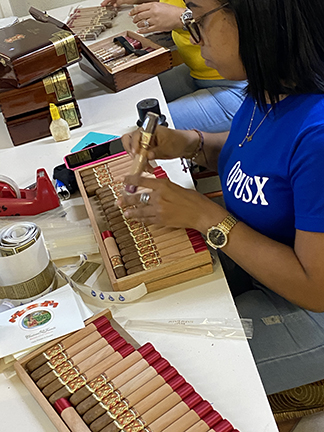 Carlito walked me to the boxing area of the factory. Only women are said to have a keen enough eye to perform this job. One woman takes the cigars and places them into their boxes, paying attention to the color of each cigar in order to make each box as consistent as possible. After boxes are filled, they are stacked up and sent to the other end of the table. Here another woman reopens the box for a second inspection. She takes one cigar out and pulls it from the cellophane.
Carlito walked me to the boxing area of the factory. Only women are said to have a keen enough eye to perform this job. One woman takes the cigars and places them into their boxes, paying attention to the color of each cigar in order to make each box as consistent as possible. After boxes are filled, they are stacked up and sent to the other end of the table. Here another woman reopens the box for a second inspection. She takes one cigar out and pulls it from the cellophane.
“The cello on that cigar had a crinkle in it, so she’s replacing it,” Carlito said as we looked over the inspector’s shoulder.
After the box passes through the second inspector, it’s handed off to the third and final inspector. Inspector three once again opens the box and examines the presentation, looks at the cello, and rearranges the cigars by color from left to right. After all the cellophane and cigars have been placed in the proper order and fixed, the last inspector places all the stickers on the box and seals it off. Every inspector has a number and a stamp that they put in the box. Every box of Fuentes will have a number of inspector stamps to ensure quality and consistency. You’ll find at least three stamps on the bottom of the box alone.
From here the cigar boxes are wrapped with cellophane and sent off to cold storage where they wait to be shared with the rest of the world. We head out to grab a bite to eat before being dropped off at the hotel. As we walked inside the restaurant Carlito handed off his keys to his bodyguard, who waited outside near the car reading a newspaper. Before saying goodbye, he told me that the next day was going to be even better. As hard as that was for me to believe, we shook hands and parted ways.
It was a big day for me not only as a Fuente fan, but also as a cigar enthusiast. Being able to see an operation of this caliber is always impressive and can actually make smoking any of their products more interesting than before.
With my mind traveling in a thousand directions and Opus X exuding from my pores, I grabbed one of the freshly rolled Opus’ I received and hit the poker table in the Gran Almirante’s casino. I threw a thousand peso bill on the table and tossed a hundred peso ante on the mark. I peeled the cap back from the Opus and stuck it in my mouth. I flipped up my cards and was hit in the face with a strong pre-light aroma and full-flavored draw of Opus X tobacco.
The three kings in my hand watched with envy.
I put another hundred pesos on my cards and waited for the other players. I nearly forgot we were playing a hand when the dealer showed two pair. Good way to start celebrating the day’s accomplishment, and a great cigar to be kicking off the night. The next day was going to be just as exciting, a trip to Chateau de la Fuente and the Cigar Family Charitable Foundation.
Chateau de la Fuente and the Cigar Family Charitable Foundation
My leg bounced and a single cup of coffee jolted my nerves. It was another hot Dominican January morning.
I was still amped up from the day before and ready to rock another unforgettable day in my cigar journey. The black Navigator pulled up and Carlito’s bodyguard opened my door. We drove to Caribe, where the farms and foundation sat in a valley under gold and nickel mines. The famous 8 Royal Palms reached into the sky, darting through cheesecloth canopies. We drove through small villages and ended up next to seedbed greenhouses.
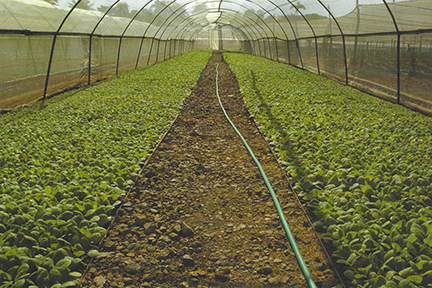 Thousands of baby Opus X tobacco plants were just spreading their wings. A sea of brilliant green tobacco plants dripped with water and sat in the hot, humid air. Each plant is individually placed in its own container so when it is transplanted into the fields the roots aren’t disturbed or broken. Only the strongest and healthiest plants reach maturity. This particular season all of the tobacco was shade-grown.
Thousands of baby Opus X tobacco plants were just spreading their wings. A sea of brilliant green tobacco plants dripped with water and sat in the hot, humid air. Each plant is individually placed in its own container so when it is transplanted into the fields the roots aren’t disturbed or broken. Only the strongest and healthiest plants reach maturity. This particular season all of the tobacco was shade-grown.
Workers in the fields carefully constructed the cheesecloth canopies over young plants. In some of the fields, plants were already over three feet tall. Each plant is individually tied up. Every two weeks workers need to re-tie every single plant and move the string higher on the plant. When the plant uses less energy to grow roots and hold itself up, it produces a leaf that is more suitable for wrappers. The veins are smaller and the leaves are physically thinner, allowing them to be beautiful in appearance and give them better combustion.
 We drove up to the gazebo that overlooked Chateau de la Fuente before heading over to the Cigar Family Charitable Foundation. Mountains rich in nickel and gold surrounded the farms. The soil is red and filled with minerals making this valley unique to any other place in the world. This gazebo overlooks everything – the mines, mountains, curing barns, seedbeds, tobacco fields, and the beautifully orchestrated gardens.
We drove up to the gazebo that overlooked Chateau de la Fuente before heading over to the Cigar Family Charitable Foundation. Mountains rich in nickel and gold surrounded the farms. The soil is red and filled with minerals making this valley unique to any other place in the world. This gazebo overlooks everything – the mines, mountains, curing barns, seedbeds, tobacco fields, and the beautifully orchestrated gardens.
Unfortunately, we didn’t have time to stay for sunset. The mines make the sky glow a brilliant orange, just like the famous picture of Carlos Senior and Junior. It adds yet another mystical tone and feel to the Fuente experience.
After relaxing for a meditative half hour overlooking the farms, we hopped back into the Navigator and drove down the road to the Cigar Family Charitable Foundation.
In Caribe there are about five villages in the same area as Chateau de la Fuente. Before the Foundation’s inception there were no schools, no medical facilities, there were barely houses. The foundation has provided all of those necessities and more, made possible entirely by donations of cigar smokers.
One hundred percent of the money goes directly to the foundation and aids in helping the lives of those less fortunate. The children who didn’t have shoes before can now speak English. It is developing into a community that helps entire villages live healthier lives and generates opportunities they never had before. There is much more to the Fuente family than cigars alone. They are making a social and economic impact on the Dominican Republic.
The Dominican Republic is a beautiful country that has been injected into my blood. Now everything from buzzing sounds of scooters racing down the highway to a hot and humid breeze echoes Fuente. After a trip like this a cigar becomes more than just a cigar . . . it becomes an experience.
Originally published in the Premiere Issue of Cigar Press, Volume 1 Issue 1, 2007, by Thor Nielsen




